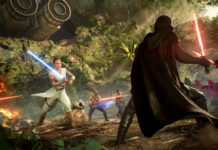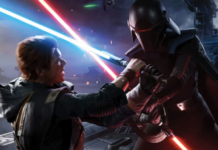|
Interview
with Michael DePlater, Producer of Shogun
Total War
Do You Have What It Takes to be Shogun?
By
Michael Lafferty
Thousands of warriors scurry across your monitor, engaged
in brutal battle. Swords flash, arrows fly and horses die on the end of
spears. It is a scene out of the past. It is 16th century Japan, and as
daimyo – or warlord – of the army, it is your job to conquer, control and
eventually rise to power over all others.
This is the world of
Shogun Total War, an Electronic Arts
release that has just hit store shelves. It is a real-time strategy game
that features panoramic, three-dimensional scenes, an engine that allows
thousands of troops to appear on computer monitors simultaneously, as well
as multiplayer action.
This is not your basic ‘command and conquer’ style of
game. This program is rich with historical challenges. Sun Tzu wrote “The
Art Of War,” perhaps the definitive book about warfare. His teachings have
been incorporated into this program. But that wasn’t the only source of
information employed in the effort to make this program stand apart from
others in the real-time strategy genre.
“There is so much in this game that is different from
everything that went before,” said Michael DePlater, producer of Shogun
Total War, “and it is also incredibly attractive to look at. This means
that it has moved out of the surreal gameplay style of ‘look down from
above and move your tanks to take on the aliens’ into a real world epic
battle style of gameplay. Furthermore, the same tactics that work in real
life can now be used for the first time within a computer game.”
DePlater is enthusiastic about this product. He took time
to explain how programmers brought a richness to the game, the challenges
faced in realizing such a grand vision, and addressed a few other topics
relating to Shogun Total War.
This product seems to combine solid animated footage
with real-time strategy. Apart from the three-dimensional look and the
specific time placement, what is going to set this apart from civ-type RTS/combat games?
DePlater: “It’s a very simple game. Archers beat spearmen
who move too slowly to avoid casualties, spearmen beat cavalry by spiking
the horse on their yari (spear), but cavalry beat archers by closing on
them quickly and trampling them underfoot (archers have light armour as
speed is more important for them to avoid close combat). So essentially
the game is very easy to understand. It is intuitive and direct, like a
game of paper, scissors, rock. It’s obvious that the spears are going to
beat the horses, or that the horses are going to trample the archers –
it’s therefore a game that immediately feels more real and less abstract
than the ‘space wars’ or ‘orcs and elves’ battles that features in most
other RTS games.
“Being as simple as paper, scissors, stone gives it an
immediacy and ease of play that other games lack. But it is in real-time
and against enemy AI that is using the rules of Sun Tzu. Over 220 rules
from Sun Tzu’s ‘Art Of War’ have been incorporated directly into the AI,
such as ‘when defending high ground, await the enemy and make them come
to you.’
“ ‘Tank Rush’ tactics do not work. You need to think about
the terrain and the weather and trying to outflank, hit from behind, surprise,
ambush or gain a height advantage. You need to think very hard about matching
units correctly, guns are cheap to obtain but archers have a greater range
so this is a major factor you need to consider when engaging the enemy
from long range (remember that they had pretty basic guns back then).
“It is certainly much deeper than other RTS games.
Each decision you make is more important because new avenues on the technology
tree open up to you. For example, if you build a spear dojo and an armory
you can build a Famous Spear Dojo, which allows the training of Naginata
(who are very tough). On the other hand you might decide to combine the
spear dojo with a horse dojo to make Cavalry Lancers. Each decision is
important because, of course, going into the next battle you need to make
sure that you have the right unit types. Also decisions such as whether
to become a Christian clan or stay Buddhist have a huge influence because
the population within your lands may want you to do one or the other. If
there is a shrine in your territory, then the warrior monks will rise against
you if you wish to become Christian. If an enemy Daimyo has controlled
a region for many years then when you take it over, the peasants will still
be loyal to him – again, they may rise up against you.
“The graphics are also revolutionary – this is the first
game to reproduce epic battles on a scale that compares to how they were
in real life. Thousands of samurai meeting on the battlefield just looks
so cool.”
How were you able to integrate so many troops and action
into single frames? Are you using an established engine, or have you come
up with new technology? What will be the minimum system requirements?
DePlater: “There was no way we were going to produce something
as innovative and revolutionary as Shogun Total War with an off the shelf
engine on the market. So that was not an option. Instead, we started with
a small core team of three people working on the most ambitious areas of
the R&D. This enabled us to address the issues of the 3D landscapes
and the displaying of thousands of men in one battle. Initially we thought
5,000 men would be an absolute maximum but now with higher-end machines
you can have towards twice that without slow down. At first we looked into
a 3D landscape with a top down camera view. However we felt that a big
failing of earlier 3D RTS games had been that it’s hard to maintain a sense of
orientation with a top down view – especially when you can rotate the camera.
So one of the first things we looked at in the R&D phase was how to
move the camera close to the ground and look across the landscape – with
a draw distance all the way to the horizon.
“When these technical achievements were combined with
the vision for the gameplay we emerged with an engine that exceeded even
our own high expectations. We began the long and challenging process of
building a complete game around the core features of beautiful 3D landscapes,
thousands of guys on the battlefield and realistic but intuitive battle
tactics.
“The min spec requirements won’t be too high because the
game is so scaleable. The technology we’ve used can run on a Pentium 200,
but will take advantage of anything up to the latest GeForce. It doesn’t
require a 3D card, though as the men are sprites moving around with multiple
angles on a spline-based environment. The castles, villages, temples and
bridges that appear on the battle maps are three-dimensional polygons.”
What kind of learning curve does this program have?
Who do you feel it will appeal to, and why?
DePlater: “We have used ‘content’ that would have worldwide
appeal – that is widely considered to be ‘cool,’ and would give us a chance
to produce a game with a strong style and well as gameplay. The Samurai
era gives us all that. We believe there is an audience for this game, from
among people who are interested in the Japanese martial arts, the history
of the country, the art of warfare or the Samurai – all of those people
will enjoy Shogun Total War.
“There is also probably a little bit of an ‘armchair general’
inside everyone, certainly every gamer and Shogun Total War really gives
you a chance to see how you fare when put in charge of armies of thousands
of Samurai. The tactics are so realistic that you get to do the things
that you always wanted to do – outflank, ambush, gain the high ground,
et cetera.
“Also, every RTS gamer should enjoy this game, they will
love it and be better strategy gamers after having played Shogun Total
War. Everyone who likes turn-based games, real-time strategy or action
games will love it.
“In terms of learning – we’ve made the game very easy
to play with the tutorial and natural learning curve already in the game
(you start with armies of three or four hundred and move up to armies of
three or four thousand and even bigger). It’s not going to be a challenge
to play, but a serious quest to master it.”
You have placed the program in 16th century Japan –
is that merely window dressing or will game players actually (though subconsciously)
learn something about the era?
DePlater: “The decision to use Japan as background was
an easy one. No other era offered so much potential – with cool characters
like Samurai, Ninja, Shinobi and Geisha – we were really selling content
that people had already bought into because so many people are interested
in Japan. The Sengoku Jidai (Japan’s age of civil war) features perfect
gameplay ingredients such as a technology race, multiple competing factions,
a society devoted to warfare and a code of honor and ethics that rewarded
the bravest warriors. In doing our research early on in the planning phase
we got hold of as many books as possible and quickly realized that more
than half of them were written by a Stephen Turnbull – so we contacted him and found that
he was in Leeds University. We were delighted when he agreed to serve as
technical consultant on our game.
“Dr. Turnbull checked everything we did to
make sure
it was historically accurate, so it’s much more than window dressing. As
for learning something, I do think people will learn something about the
history of Japan by playing the game and could even learn a few words of
the language if they played it with the Japanese speech and English subtitles.”
What was the greatest challenge in bringing this game
to life? How long has it been in development? Is there any aspect of this
program that you would change?
DePlater: “The greatest challenge is combining the gameplay
with the technology. As I mentioned earlier, the key to success was being
able to handle gameplay and technology issues in unison. It is the merging
of good new technology with good gameplay ideas that makes for great and
innovative games.
“From the start we had pretty clear ideas of what we wanted
to do and developed technology to enable us to do that. But then there
is a long and arduous process where you match those two parts of the game.
The game will be released almost exactly three years after we started that
process. Along with the artificial intelligence, which I think is exceptionally
good and I’m very proud of it, I think the presentation of information
is also very good.
“Originally when we released the demo we were getting
hundreds of e-mails every day telling us how great the graphics are, but
two weeks later the same people were e-mailing us again to tell us how
great the user interface is. In reality, controlling the movement of thousands
of samurai on a battlefield is a pretty tough job, requiring not just a
booming voice and a detailed communications system (the Japanese used flags),
but also a personal leadership factor that meant men followed your orders
and risked their lives for your cause.
“On a Japanese battlefield, each squadron is led by a
unit general (Kashira) and the army would be led by a General (Taisho).
(Note that the clan was led by a Daimyo – Warlord – who could, of
course, come on the battlefield himself). It would be very complicated
for the Daimyo to give orders to every single Samurai so instead the system
was for the General to give orders to the unit leaders who would then lead
by example as their troops followed them into battle. In the game you give
orders to each unit leader and you know the name of each unit leader so you can watch their progress (even asking them
to commit hara-kiri if they don’t live up to your high standards). On the
battlefield then you look after a certain amount of units, each of which
is made up of around 120 samurai, so while there can be four or five thousand
troops on the screen, it never gets too complicated.
“Each unit icon shows you the type of unit, their health,
their current activity, their current morale, level of fatigue, honor and
how much ammo they have. It is presented in a very clear and simple way
and yet it gives you all the information you need to know at a glance while
also attracting your attention when your units are under attack or thinking
about running away.”
What is the AI of the game like? I assume there will
be a variety of difficulty levels and scenarios to introduce beginners
to the intricacies of the game – what kind of challenges will they present?
DePlater: “I think the artificial intelligence (AI) is
the most revolutionary aspect because it is the first time that the computer
is going to play so intelligently as to be almost indistinguishable from
a real human player. Because the general of the AI army is using the rules
of Sun Tzu, and each individual in that army is also running an independent
and unique AI routine – they’re going to be really smart when combined.
“Each individual samurai on the battlefield has his own
artificial intelligence so they will make decisions based on what you ask
them to do. For example asking twenty light archers to attack one hundred
heavy cavalry will probably make so little sense to them that they will
just desert your army. On the other hand leading them wisely will improve
their morale and fighting ability, for example if they can see thousands
of samurai wearing their color all around them, they will feel just great!
“In terms of
gameplay, we identified that having some
more realistic and intuitive tactics would be a key point of difference
compared to the ‘grab and point’ of units of traditional RTS, and looked
at different routes to get there. Real tactics meant that the AI was going
to be critical to the gameplay so we invested a lot of effort into this
area. We had two main challenges – firstly getting 5,000 individual units
to behave intelligently, and secondly applying actual battlefield tactics
in real time. We broke these problems down and to some extent tackled them independently – having a number of AI programmers working
together. We also found a lot of inspiration in the rules of Sun Tzu’s
‘The Art Of War,’ which are still applicable today. Since they have stood
the test of time so well and are so explicit, it was possible to implement
many of them straight into the code – we took the rules for the Field General
AI directly from Sun Tzu.
“The same old strategies that were developed for all the
‘grab and point’ type games simply will not work. The ‘tank rush’ that
you used to kill off the enemy AI in other games will simply cause you
to lose horribly. Instead you’ll have to think much more deeply about using
the terrain, the unit types, the weather and maneuvers (such as outflanking)
to your advantage. If you are in a rush to build the greatest possible
technologies then you will have to risk having only a small army at the
start of the game. On the other hand if you have huge armies near the start
of the game you won’t have money to invest in great technologies (because
you’ll have to spend all your money just feeding those Samurai). You also
have difficult choice to make between Christianity and Buddhism, guns and
warrior monks and more. The game is really about striking a balance and
there is no single path to victory that will work every time.
“In terms of beginners, there is a tutorial for them to
learn the basics of moving and controlling an army and to help them match
units correctly while taking advantage of hills, forests, castle walls,
et cetera. When you first play the game there is only a small army under
your control so you begin with small armies and build up to the armies
of six or seven thousand relatively slowly. This is a natural learning
curve that helps the gamer get into the game gradually, but which they’ll
find pretty addictive.
“There are also famous historical battles that you can
play and these range from the very easy to the very hard but always remain
accurate in that you play with the same troops in the same weather as the
battle really took place. There is plenty in Shogun Total War to keep any
player going for a very long time, whether they really love the strategic
campaigning, the historic battles, the multiplayer head-to-head or all
of the above, they’ll certainly enjoy many, many hours of happy gaming.”
|







